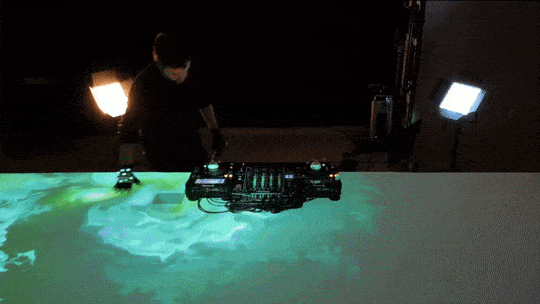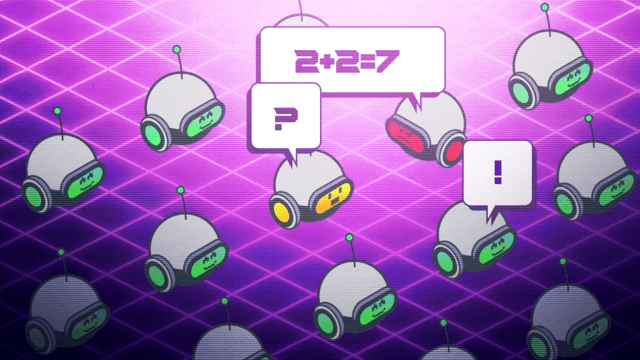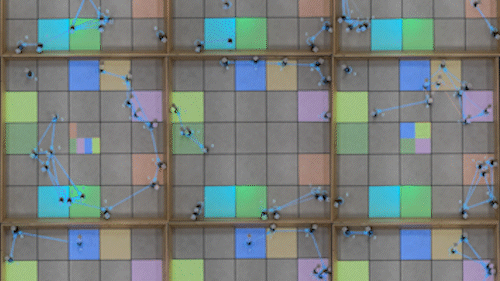Publications

07-2025
DJESTHESIA: Tangible Multimedia for DJs
Abstract:
DJESTHESIA uses tangible interaction to craft real-time audiovisual multimedia, blending sound, visuals, and gestures into a unified live performance. The project supports four interaction modes: I) Knob changes music, where standard DJing is performed. II) Music changes visuals, where changes in the audio parameters done through the mixer have a direct impact in the visualizations representing the music (e.g., color palette). III) Gesture changes visuals, where gestures and body movements give the possibility to interact physically with the visual representation of the music (e.g., grab, release, throw). IV) Gesture changes music, where, gestures can convey information to an audio composition software to alter aspects of the music being played (e.g., EQs). The aim of DJESTHESIA is to transform the DJ into both a performer and a performance.

02-2025
iTrash: Incentivized Token Rewards for Automated Sorting and Handling
Abstract:
As robotic systems (RS) become more autonomous, they are becoming increasingly used in small spaces and offices to automate tasks such as cleaning, infrastructure maintenance, or resource management. In this paper, we propose iTrash, an intelligent trashcan that aims to improve recycling rates in small office spaces. For that, we ran a 5 day experiment and found that iTrash can produce an efficiency increase of more than 30% compared to traditional trashcans. The findings derived from this work, point to the fact that using iTrash not only increase recyclying rates, but also provides valuable data such as users behaviour or bin usage patterns, which cannot be taken from a normal trashcan. This information can be used to predict and optimize some tasks in these spaces. Finally, we explored the potential of using blockchain technology to create economic incentives for recycling, following a Save-as-you-Throw (SAYT) model.

12-2024
SPICE: Smart Projection Interface for Cooking Enhancement
Abstract:
Tangible User Interfaces (TUI) for human--computer interaction (HCI) provide the user with physical representations of digital information with the aim to overcome the limitations of screen-based interfaces. Although many compelling demonstrations of TUIs exist in the literature, there is a lack of research on TUIs intended for daily two-handed tasks and processes, such as cooking. In response to this gap, we propose SPICE (Smart Projection Interface for Cooking Enhancement). SPICE investigates TUIs in a kitchen setting, aiming to transform the recipe following experience from simply text-based to tangibly interactive. SPICE includes a tracking system, an agent-based software, and vision large language models to create and interpret a kitchen environment where recipe information is projected directly onto the cooking surface.

12-2024
Multimodal Sentiment Analysis based on Video and Audio Inputs
Abstract:
Despite the abundance of current research working on the sentiment analysis from videos and audios, finding the best model that gives the highest accuracy rate is still considered a challenge for researchers in this field.
The main objective of this paper is to prove the usability of emotion recognition models that take video and audio inputs. The datasets used to train the models are the CREMA-D dataset for audio and the RAVDESS dataset for video. The fine-tuned models that been used are: Facebook/wav2vec2-large for audio and the Google/vivit-b-16x2-kinetics400 for video. The average of the probabilities for each emotion generated by the two previous models is utilized in the decision-making framework. After disparity in the results, if one of the models gets much higher accuracy, another test framework is created.

11-2024
GAME: GrAspable Media Entertainment
Abstract:
This research explores the development of a Tangible User Interface (TUI) designed for gaming purposes. GAME (GrAspable Media Entertainment) is an innovative project that enables users to physically interact with digital gaming elements, bridging the gap between the physical and virtual worlds. This is achieved through the integration of multiple technologies, including a motion capture system (Optitrack), a short-throw projector (Optoma UHD35STx), and an agent-based simulation software (GAMA). GAME supports interactive gameplay (e.g., Player vs. Player, Player vs. AI), offering a more immersive and versatile gaming experience than conventional screen-based implementations. Furthermore, GAME leverages blockchain technology, specifically the Ripple protocol (i.e., XRPL), to facilitate gameplay actions such as store progress checkpoints, secure in-game transactions, and track player scores. The addition of the blockchain component allows easy game customization, and enhances the overall gaming experience. In conclusion, the combination of tangible user interfaces with blockchain technology can pave the way for future developments in important fields such as education, training, and entertainment where novel interaction methods are paramount.

05-2023
If blockchain is the solution, robot security is the problem
Abstract:
Robotics systems of all types are revolutionizing a wide variety of industries—transportation, manufacturing, and even healthcare—and yet, many essential ingredients for robotics systems in the real world are not technologically ready for deployment. Currently, robots lack the protocols and standards required to be safe and secure outside factories. In an attempt to close this gap, recent research has demonstrated the security benefits of combining robotics systems with blockchain-based and related technologies (e.g., smart contracts, zero-knowledge proofs). In this article, I argue that blockchain-based robotics is starting to provide innovative solutions to urgent problems of robot security. I list the most important takeaways so far from this field that I helped establish together with a growing community. I close the article by discussing the implications of the security challenges that the robotics research community is facing, and possible ways for us to move forward.

03-2023
Gaka-Chu: A Self-Employed Autonomous Robot Artist
Abstract:
In this paper, we present the first economically autonomous robot -- a robot able to produce marketable goods while having full control over the use of its generated income. Gaka-chu ("painter" in Japanese) is a 6-axis robot arm that creates paintings of Japanese characters from an autoselected keyword. By using a blockchain-based smart contract, Gaka-chu can autonomously list a painting it made for sale in an online auction. In this transaction, the robot interacts with the human bidders as a peer not as a tool.

07-2021
Secure and secret cooperation in robot swarms
Abstract:
The importance of swarm robotics systems in both academic research and real-world applications is steadily increasing. However, to reach widespread adoption, new models that ensure the secure cooperation of large groups of robots need to be developed. This work introduces a method to encapsulate cooperative robotic missions in an authenticated data structure known as a Merkle tree. With this method, operators can provide the "blueprint" of the swarm’s mission without disclosing its raw data. In other words, data verification can be separated from data itself. We propose a system where robots in a swarm, to cooperate toward mission completion, have to “prove” their integrity to their peers by exchanging cryptographic proofs. We show the implications of this approach for two different swarm robotics missions: foraging and maze formation. In both missions, swarm robots were able to cooperate and carry out sequential tasks without having explicit knowledge about the mission’s high-level objectives. The results presented in this work demonstrate the feasibility of using Merkle trees as a cooperation mechanism for swarm robotics systems in both simulation and real-robot experiments, which has implications for future decentralized robotics applications where security plays a crucial role.